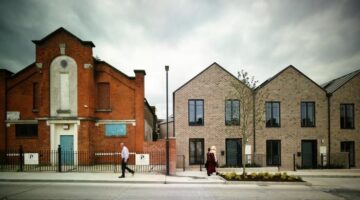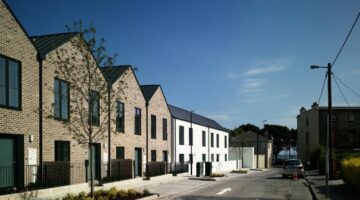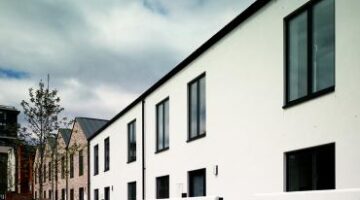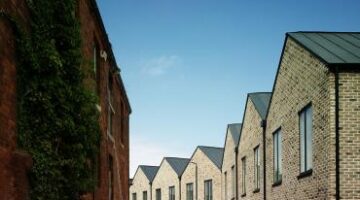




Rapid Delivery Housing
Main objectives of the project
Dublin's metropolitan area is grappling with a housing shortage across both private and public sectors, prompting exploration into methods for swiftly accelerating housing delivery. In Dún Laoghaire, the challenge has been to devise a project that not only addresses the urgent need for social housing but also employs factory-built components to expedite construction while upholding exceptionally high building and energy standards. The new development at Georges Place epitomizes this objective, simultaneously revitalizing the urban landscape and reconnecting the town center with its waterfront. Situated on a former Council Depot site that lay vacant and underutilized, its proximity to the sea, mere hundreds of meters away, renders it an optimal location to meet the pressing demand for high-density family housing with individual entrances.
Date
- 2019: Ganador
- 2017: Construction
Stakeholders
- Promotor: Dún Laoghaire Municipality
- Architect: A2 Architects
- Architect: DLR Architects
Location
Country/Region: Dublin, Ireland
Description
Until recently, Dún Laoghaire had been marked by a notable physical and perceptual division between the town and its waterfront, a key asset lending the town its distinctive identity. This divide, largely attributed to the presence of a rapid transit corridor, has been successfully addressed through a series of public realm projects, effectively reconnecting the town center with the waterfront. However, alongside these positive changes, the town has experienced a decline in its residential population and retail performance due to competition from out-of-town retail establishments. In response, the Local Authority devised the Dún Laoghaire Urban Framework Plan, a strategic initiative spanning twenty years, aimed at mitigating these challenges. Central to this plan is the revitalization of Georges Place, a previously vacant area with the potential to densify and rejuvenate the town center while strengthening its connection to the waterfront. Notably, Georges Place comprises various building typologies, including two- and three-story houses, multi-story apartment blocks, and pockets of commercial activity. Leveraging the former Council Depot, the project sought to deliver high-density urban dwellings with individual entrances while respecting the area's character.
The project was guided by four primary objectives: firstly, to create new housing at optimal densities to maximize the value of brownfield land, while providing family-friendly accommodations with individual access; secondly, to bolster the town's residential population to support its regeneration efforts; thirdly, to establish new pedestrian pathways to channel visitors towards the seafront and commercial hub of the town; and finally, to serve as an exemplar project demonstrating the efficacy of collaboration between public and private sector entities in design and construction.
The outcome of the project manifests in twelve high-quality, energy-efficient A1-rated dwellings. Despite each unit having its own entrance, the development achieves a density of 67 dwellings per hectare, ensuring sustainable utilization of valuable urban land. Notably, the incorporation of shallow, railed-front gardens and small courtyard spaces exemplifies a strategic approach to limiting the external footprint of each house. Architecturally, the design fosters passive surveillance and overlooks public areas, with splayed windows on the first floor minimizing direct sightlines between neighboring units. Additionally, residents have access to shared parking spaces situated within 'home zones,' informal play and amenity areas overlooked by the houses themselves.
A cohesive palette of self-finished materials was employed to harmonize with the area's character and sensitive context, particularly adjoining protected structures. This includes flush-pointed multi-stock buff brickwork, self-colored plaster, graphite zinc standing seam roofing, and simple repeating double-casement triple-glazed windows and doors. Further enhancements such as honed granite railing upstands, powder-coated railings and gates, and herringbone brick paving contribute to the project's aesthetic and functional appeal. Additionally, landscaping elements such as Ash trees along Kelly's Avenue and laurel hedging with lavender beds enhance the threshold spaces of each house.
Construction of the development followed a design-build public works contract, adhering to a rapid delivery program. Planning permission was submitted to the local authority's internal planning process in September 2016, followed by a tender process in February of the subsequent year, with contracts finalized by October 2017. To expedite construction without compromising quality, significant components of the project were prefabricated offsite, ensuring adherence to high standards.
The success of the development was acknowledged through its receipt of the 'Living - Housing Schemes' category award and the 'Sustainability' award at the 2019 RIAI Awards.

